[English] 日本語
 Yorodumi
Yorodumi- PDB-2pea: NMR Based Structure of the Closed Conformation of LYS48-Linked Di... -
+ Open data
Open data
- Basic information
Basic information
| Entry | Database: PDB / ID: 2pea | ||||||
|---|---|---|---|---|---|---|---|
| Title | NMR Based Structure of the Closed Conformation of LYS48-Linked Di-Ubiquitin Using Experimental Global Rotational Diffusion Tensor from NMR Relaxation Measurements | ||||||
 Components Components | Ubiquitin | ||||||
 Keywords Keywords |  SIGNALING PROTEIN / SIGNALING PROTEIN /  UBIQUITIN / LYS48-LINKED DI-UBIQUITIN / POLYUBIQUITIN UBIQUITIN / LYS48-LINKED DI-UBIQUITIN / POLYUBIQUITIN | ||||||
| Function / homology |  Function and homology information Function and homology information: / : / protein modification process => GO:0036211 / Peptide chain elongation / Selenocysteine synthesis / Formation of a pool of free 40S subunits / Eukaryotic Translation Termination / Response of EIF2AK4 (GCN2) to amino acid deficiency / SRP-dependent cotranslational protein targeting to membrane / Viral mRNA Translation ...: / : / protein modification process => GO:0036211 / Peptide chain elongation / Selenocysteine synthesis / Formation of a pool of free 40S subunits / Eukaryotic Translation Termination / Response of EIF2AK4 (GCN2) to amino acid deficiency / SRP-dependent cotranslational protein targeting to membrane / Viral mRNA Translation / Nonsense Mediated Decay (NMD) independent of the Exon Junction Complex (EJC) / GTP hydrolysis and joining of the 60S ribosomal subunit / L13a-mediated translational silencing of Ceruloplasmin expression / Major pathway of rRNA processing in the nucleolus and cytosol / Nonsense Mediated Decay (NMD) enhanced by the Exon Junction Complex (EJC) / Maturation of protein E / Maturation of protein E / ER Quality Control Compartment (ERQC) / Myoclonic epilepsy of Lafora / FLT3 signaling by CBL mutants / Prevention of phagosomal-lysosomal fusion / IRAK2 mediated activation of TAK1 complex / Alpha-protein kinase 1 signaling pathway /  Glycogen synthesis / IRAK1 recruits IKK complex / IRAK1 recruits IKK complex upon TLR7/8 or 9 stimulation / Membrane binding and targetting of GAG proteins / Constitutive Signaling by NOTCH1 HD Domain Mutants / NOTCH2 Activation and Transmission of Signal to the Nucleus / Endosomal Sorting Complex Required For Transport (ESCRT) / IRAK2 mediated activation of TAK1 complex upon TLR7/8 or 9 stimulation / Regulation of FZD by ubiquitination / PTK6 Regulates RTKs and Their Effectors AKT1 and DOK1 / Negative regulation of FLT3 / TICAM1,TRAF6-dependent induction of TAK1 complex / TICAM1-dependent activation of IRF3/IRF7 / APC/C:Cdc20 mediated degradation of Cyclin B / Downregulation of ERBB4 signaling / p75NTR recruits signalling complexes / TRAF6 mediated IRF7 activation in TLR7/8 or 9 signaling / APC-Cdc20 mediated degradation of Nek2A / PINK1-PRKN Mediated Mitophagy / TRAF6-mediated induction of TAK1 complex within TLR4 complex / InlA-mediated entry of Listeria monocytogenes into host cells / Pexophagy / Regulation of innate immune responses to cytosolic DNA / VLDLR internalisation and degradation / Downregulation of ERBB2:ERBB3 signaling / NRIF signals cell death from the nucleus / Activated NOTCH1 Transmits Signal to the Nucleus / Translesion synthesis by REV1 / NF-kB is activated and signals survival / Glycogen synthesis / IRAK1 recruits IKK complex / IRAK1 recruits IKK complex upon TLR7/8 or 9 stimulation / Membrane binding and targetting of GAG proteins / Constitutive Signaling by NOTCH1 HD Domain Mutants / NOTCH2 Activation and Transmission of Signal to the Nucleus / Endosomal Sorting Complex Required For Transport (ESCRT) / IRAK2 mediated activation of TAK1 complex upon TLR7/8 or 9 stimulation / Regulation of FZD by ubiquitination / PTK6 Regulates RTKs and Their Effectors AKT1 and DOK1 / Negative regulation of FLT3 / TICAM1,TRAF6-dependent induction of TAK1 complex / TICAM1-dependent activation of IRF3/IRF7 / APC/C:Cdc20 mediated degradation of Cyclin B / Downregulation of ERBB4 signaling / p75NTR recruits signalling complexes / TRAF6 mediated IRF7 activation in TLR7/8 or 9 signaling / APC-Cdc20 mediated degradation of Nek2A / PINK1-PRKN Mediated Mitophagy / TRAF6-mediated induction of TAK1 complex within TLR4 complex / InlA-mediated entry of Listeria monocytogenes into host cells / Pexophagy / Regulation of innate immune responses to cytosolic DNA / VLDLR internalisation and degradation / Downregulation of ERBB2:ERBB3 signaling / NRIF signals cell death from the nucleus / Activated NOTCH1 Transmits Signal to the Nucleus / Translesion synthesis by REV1 / NF-kB is activated and signals survival /  Regulation of BACH1 activity / Regulation of PTEN localization / Translesion synthesis by POLK / Synthesis of active ubiquitin: roles of E1 and E2 enzymes / Translesion synthesis by POLI / MAP3K8 (TPL2)-dependent MAPK1/3 activation / Gap-filling DNA repair synthesis and ligation in GG-NER / TICAM1, RIP1-mediated IKK complex recruitment / Downregulation of TGF-beta receptor signaling / cytosolic ribosome / Josephin domain DUBs / Activation of IRF3, IRF7 mediated by TBK1, IKKε (IKBKE) / Regulation of activated PAK-2p34 by proteasome mediated degradation / InlB-mediated entry of Listeria monocytogenes into host cell / IKK complex recruitment mediated by RIP1 / JNK (c-Jun kinases) phosphorylation and activation mediated by activated human TAK1 / TGF-beta receptor signaling in EMT (epithelial to mesenchymal transition) / N-glycan trimming in the ER and Calnexin/Calreticulin cycle / Autodegradation of Cdh1 by Cdh1:APC/C / TNFR1-induced NF-kappa-B signaling pathway / APC/C:Cdc20 mediated degradation of Securin / Asymmetric localization of PCP proteins / TCF dependent signaling in response to WNT / SCF-beta-TrCP mediated degradation of Emi1 / Regulation of NF-kappa B signaling / NIK-->noncanonical NF-kB signaling / Ubiquitin-dependent degradation of Cyclin D / AUF1 (hnRNP D0) binds and destabilizes mRNA / Negative regulators of DDX58/IFIH1 signaling / NOTCH3 Activation and Transmission of Signal to the Nucleus / TNFR2 non-canonical NF-kB pathway / activated TAK1 mediates p38 MAPK activation / Assembly of the pre-replicative complex / Degradation of DVL / Vpu mediated degradation of CD4 / Deactivation of the beta-catenin transactivating complex / Recognition of DNA damage by PCNA-containing replication complex / Ubiquitin Mediated Degradation of Phosphorylated Cdc25A / Regulation of signaling by CBL / Dectin-1 mediated noncanonical NF-kB signaling / Hh mutants are degraded by ERAD / Cdc20:Phospho-APC/C mediated degradation of Cyclin A / Fanconi Anemia Pathway / Negative regulation of FGFR3 signaling / Regulation of BACH1 activity / Regulation of PTEN localization / Translesion synthesis by POLK / Synthesis of active ubiquitin: roles of E1 and E2 enzymes / Translesion synthesis by POLI / MAP3K8 (TPL2)-dependent MAPK1/3 activation / Gap-filling DNA repair synthesis and ligation in GG-NER / TICAM1, RIP1-mediated IKK complex recruitment / Downregulation of TGF-beta receptor signaling / cytosolic ribosome / Josephin domain DUBs / Activation of IRF3, IRF7 mediated by TBK1, IKKε (IKBKE) / Regulation of activated PAK-2p34 by proteasome mediated degradation / InlB-mediated entry of Listeria monocytogenes into host cell / IKK complex recruitment mediated by RIP1 / JNK (c-Jun kinases) phosphorylation and activation mediated by activated human TAK1 / TGF-beta receptor signaling in EMT (epithelial to mesenchymal transition) / N-glycan trimming in the ER and Calnexin/Calreticulin cycle / Autodegradation of Cdh1 by Cdh1:APC/C / TNFR1-induced NF-kappa-B signaling pathway / APC/C:Cdc20 mediated degradation of Securin / Asymmetric localization of PCP proteins / TCF dependent signaling in response to WNT / SCF-beta-TrCP mediated degradation of Emi1 / Regulation of NF-kappa B signaling / NIK-->noncanonical NF-kB signaling / Ubiquitin-dependent degradation of Cyclin D / AUF1 (hnRNP D0) binds and destabilizes mRNA / Negative regulators of DDX58/IFIH1 signaling / NOTCH3 Activation and Transmission of Signal to the Nucleus / TNFR2 non-canonical NF-kB pathway / activated TAK1 mediates p38 MAPK activation / Assembly of the pre-replicative complex / Degradation of DVL / Vpu mediated degradation of CD4 / Deactivation of the beta-catenin transactivating complex / Recognition of DNA damage by PCNA-containing replication complex / Ubiquitin Mediated Degradation of Phosphorylated Cdc25A / Regulation of signaling by CBL / Dectin-1 mediated noncanonical NF-kB signaling / Hh mutants are degraded by ERAD / Cdc20:Phospho-APC/C mediated degradation of Cyclin A / Fanconi Anemia Pathway / Negative regulation of FGFR3 signaling /  Peroxisomal protein import / Termination of translesion DNA synthesis / Downregulation of SMAD2/3:SMAD4 transcriptional activity / Degradation of GLI1 by the proteasome Peroxisomal protein import / Termination of translesion DNA synthesis / Downregulation of SMAD2/3:SMAD4 transcriptional activity / Degradation of GLI1 by the proteasomeSimilarity search - Function | ||||||
| Biological species |   Homo sapiens (human) Homo sapiens (human) | ||||||
| Method |  SOLUTION NMR SOLUTION NMR | ||||||
 Authors Authors | Ryabov, Y. / Fushman, D. | ||||||
 Citation Citation |  Journal: J.Am.Chem.Soc. / Year: 2007 Journal: J.Am.Chem.Soc. / Year: 2007Title: Structural assembly of multidomain proteins and protein complexes guided by the overall rotational diffusion tensor. Authors: Ryabov, Y. / Fushman, D. #1: Journal: J.Am.Chem.Soc. / Year: 2006 Title: An efficient computational method for predicting rotational diffusion tensors of globular proteins using an ellipsoid representation. Authors: Ryabov, Y. / Geraghty, C. / Varshney, A. / Fushman, D. #2: Journal: J.Am.Chem.Soc. / Year: 2007 Title: A Model of Interdomain Mobility in a Multidomain Protein Authors: Ryabov, Y. / Fushman, D. #3: Journal: J.Mol.Biol. / Year: 2002 Title: Structural Properties of Polyubiquitin Chains in Solution Authors: Varadan, R. / Walker, O. / Pickart, C. / Fushman, D. | ||||||
| History |
|
- Structure visualization
Structure visualization
| Structure viewer | Molecule:  Molmil Molmil Jmol/JSmol Jmol/JSmol |
|---|
- Downloads & links
Downloads & links
- Download
Download
| PDBx/mmCIF format |  2pea.cif.gz 2pea.cif.gz | 57.6 KB | Display |  PDBx/mmCIF format PDBx/mmCIF format |
|---|---|---|---|---|
| PDB format |  pdb2pea.ent.gz pdb2pea.ent.gz | 46.5 KB | Display |  PDB format PDB format |
| PDBx/mmJSON format |  2pea.json.gz 2pea.json.gz | Tree view |  PDBx/mmJSON format PDBx/mmJSON format | |
| Others |  Other downloads Other downloads |
-Validation report
| Arichive directory |  https://data.pdbj.org/pub/pdb/validation_reports/pe/2pea https://data.pdbj.org/pub/pdb/validation_reports/pe/2pea ftp://data.pdbj.org/pub/pdb/validation_reports/pe/2pea ftp://data.pdbj.org/pub/pdb/validation_reports/pe/2pea | HTTPS FTP |
|---|
-Related structure data
- Links
Links
- Assembly
Assembly
| Deposited unit | 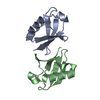
| |||||||||
|---|---|---|---|---|---|---|---|---|---|---|
| 1 |
| |||||||||
| NMR ensembles |
|
- Components
Components
| #1: Protein |  / UBIQUITIN / UBIQUITINMass: 8576.831 Da / Num. of mol.: 2 Source method: isolated from a genetically manipulated source Source: (gene. exp.)   Homo sapiens (human) / Production host: Homo sapiens (human) / Production host:   Escherichia coli (E. coli) / References: UniProt: P62988, UniProt: P0CG48*PLUS Escherichia coli (E. coli) / References: UniProt: P62988, UniProt: P0CG48*PLUS |
|---|
-Experimental details
-Experiment
| Experiment | Method:  SOLUTION NMR SOLUTION NMR | ||||||||||||||||||||||||||||||||
|---|---|---|---|---|---|---|---|---|---|---|---|---|---|---|---|---|---|---|---|---|---|---|---|---|---|---|---|---|---|---|---|---|---|
| NMR experiment |
|
- Sample preparation
Sample preparation
| Details | Contents: DI-UBIQUITIN, 90% WATER/10% D20 |
|---|---|
| Sample conditions | Ionic strength: 20mM / pH: 6.8 / Pressure: AMBIENT / Temperature: 298.0 K |
-NMR measurement
| Radiation | Protocol: SINGLE WAVELENGTH / Monochromatic (M) / Laue (L): M |
|---|---|
| Radiation wavelength | Relative weight: 1 |
| NMR spectrometer | Type: Bruker AVANCE / Manufacturer: Bruker / Model : AVANCE / Field strength: 600 MHz : AVANCE / Field strength: 600 MHz |
- Processing
Processing
| NMR software |
| |||||||||
|---|---|---|---|---|---|---|---|---|---|---|
| Refinement | Software ordinal: 1 Details: THE STRUCTURE WAS DETERMINED WITH PROGRAM ELM USING COMPLETE ROTATIONAL DIFFUSION TENSOR OF DI-UBIQUITIN AS EXPERIMENTAL RESTRAINT FOR BOTH ORIENTATION AND POSITIONING OF THE INDIVIDUAL ...Details: THE STRUCTURE WAS DETERMINED WITH PROGRAM ELM USING COMPLETE ROTATIONAL DIFFUSION TENSOR OF DI-UBIQUITIN AS EXPERIMENTAL RESTRAINT FOR BOTH ORIENTATION AND POSITIONING OF THE INDIVIDUAL UBIQUITIN DOMAINS WITHIN THE MOLECULE. UBIQUITIN DOMAINS WHERE ORIENTED BY A RIGID BODY ROTATION USING EXPERIMENTALLY DERIVED PRINCIPAL AXES FRAME OF THE DIFFUSION TENSOR (SEE REFERENCE 2). THE RELATIVE DOMAIN POSITIONS IN DI-UBIQUITIN WERE DETERMINED BY A RIGID BODY TRANSLATION USING ALL COMPONENTS OF THE EXPERIMENTALLY DERIVED ROTATIONAL DIFFUSION TENSOR AS RESTRAINTS. FOR EACH UBIQUITIN DOMAIN THE STRUCTURE OF THE FIRST CONFORMER OF PDB ENTRY 1D3Z WAS ASSUMED. THE DEPOSITED CONFORMATION REPRESENTS ONE OF THE TWO EXPERIMENTALLY DETECTABLE CONFORMATIONS OF DI-UBIQUITIN AT PH 6.8. THE OCCUPATION PROBABILITY OF THIS CONFORMATION IS APPROXIMATELY 90%. CHAIN A CORRESPONDS TO UBIQUITIN DOMAIN THAT HAS A FREE C-TERMINUS IN DI-UBIQUITIN. CHAIN B CORRESPONDS TO UBIQUITIN DOMAIN THAT IN DI-UBIQUITIN IS LINKED VIA AN ISOPEPTIDE BOND BETWEEN ITS C- TERMINAL GLY76 AND LYS48 OF CHAIN A. THE ISOPEPTIDE BOND WAS PRESENT IN THE DI-UBIQUITIN MOLECULE IN THIS STUDY. HOWEVER, BECAUSE THIS STRUCTURE WAS OBTAINED BY A RIGID BODY ROTATION AND TRANSLATION AND NO CONSTRAINTS REPRESENTING THE INTERDOMAIN LINKAGE WERE INCLUDED, THE ISOPEPTIDE LINKAGE IS NOT PRESENT IN THE STRUCTURE. FLEXIBLE C-TERMINI OF BOTH UBIQUTIN DOMAINS (RESIDUES 73-76)WERE EXCLUDED FROM THE NMR RATA ANALYSIS AND THEREFORE ARE NOT PRESENT IN THIS STRUCTURE. | |||||||||
| NMR representative | Selection criteria: lowest energy | |||||||||
| NMR ensemble | Conformer selection criteria: structures with the lowest energy Conformers submitted total number: 1 |
 Movie
Movie Controller
Controller




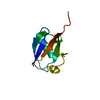



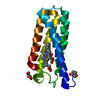

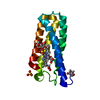



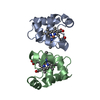

 PDBj
PDBj























